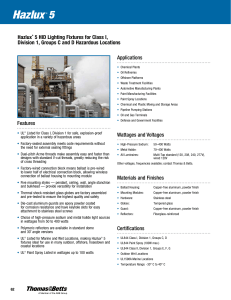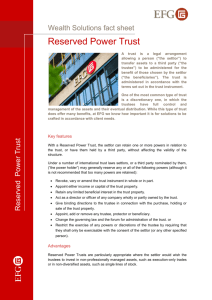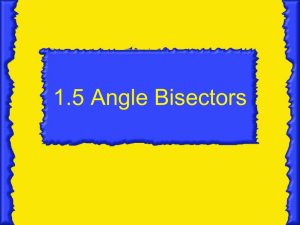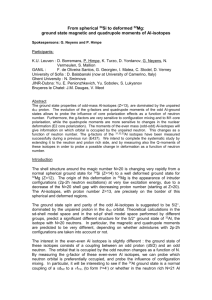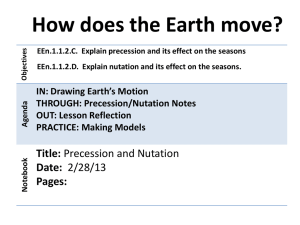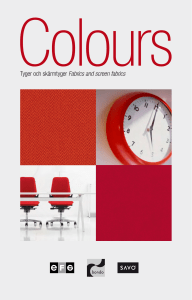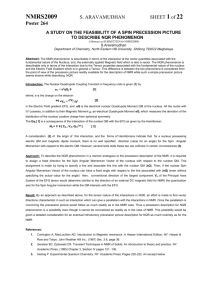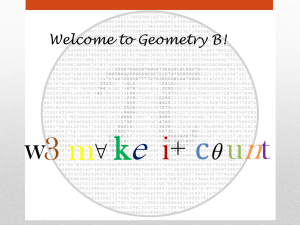Report on update of Tables of Nuclear Magnetic Dipole and Electric
advertisement
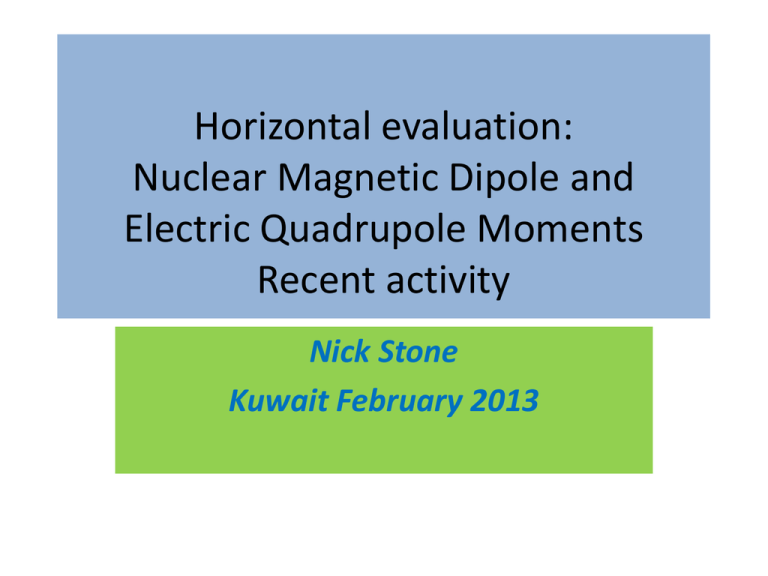
Horizontal evaluation: Nuclear Magnetic Dipole and Electric Quadrupole Moments Recent activity Nick Stone Kuwait February 2013 Outline Update of the General Table – involvement now more than 15 years. Done for 2010/11 and 2011/12 ongoing for 2012/13 6192 line spreadsheet – new entries ~ 80/year 03-09 – more 2010 (fewer 2011) Magnetic Moments Results of interest since 2011 Sc isotopes across the f7/2 neutron shell and f7/2 proton shell filling Sn and Te: 2+ state g-factors Ti 9/2+ hyperfine anomaly corrections New methods HVTF on 72Zn Paul trap laser spectroscopy in 229Th A problem case Reported -4 nm moment in 72As 8+ state Quadrupole Moments Status of the new Recommended Value Table Major changes Problem elements New moment results 1. Scandium Ground States M. Avgoulea et al J Phys G 38 025104 (2011) 43,45Sc 2011Av01 7/2- ground states, 44,46Sc odd-odd ground states and isomers in 44,45Sc Standard laser spectroscopy at Jyvaskylla with improved Sc yields from IGISOL system T.Ohtsubo et al PRL 109 032504 (2012) 2012Oh01 NMR on-line at Nicole Facility Isolde CERN 49Sc ground state Shows complete sequence of single f7/2 proton configurations from zero f7/2 neutrons (41Sc) to the full 8 f7/2 neutrons (49Sc) Demonstrating variation of configuration mixing across neutron subshell filling with respect to Schmidt limit. Also completes sequence of odd numbers of f7/2 protons all with full f7/2 neutron subshell from 49Sc to 55Co. f7/2 neutrons f7/2 protons Red triangles show best available theory : Towner at 49Sc and Honma et al . for Sc – Co sequence. New moment results 2. Sn First 2+ g-factors Sn 2+ (Walker TF), Kumbartski (TF) and Allmond (RIV)] to be published. Old measurements (Hass 1980) suggested some of the first negative g’s for 2+ states in heavier Sn even-A isotopes Recent work (TF and RIV) have reached some kind of consensus, showing a steady fall as A increases Walker et al PR C84 014319 (2011) 2011Wa15 112,114,116,122,124Sn claim high precision Kumbartski et al PR C86 034319 (2012) 2012Ku14 RIB TF method 124,126Sn 126 definitely negative Allmond et al – in preparation for PR 2013 smaller errors at 124,126,128Sn by RIV complex composition of the 2+ states clearly neutron dominated at higher N – as expected for major closed-shell Z=50 at Sn. New moment results 3. g-factor of 2+ at closed n shell 134Te Second radioactive beam measurement at HRIBF, Oak Ridge National Lab following 132Te. Stuchbery et al in preparation – preliminary result - shows sharp rise in g-factor in 134Te as compared to sequence of lower even-even Te isotopes. Several theoretical predictions what will be measured in 136Te ??? New Moment results 4. Tl Isomers Hyperfine anomaly Barzakh et al. Gatchina PR C86 014311 (2012) 2012Ba32 One of few papers to make serious hyperfine anomaly corrections based on fully resolved hfs. Previously only S states measured. New data A parameters for p1/2 and s1/2 atomic states (p - no anomaly s – contact term anomaly) found differences in ratios for two isotopes at the 1.3 – 2.0% level with error about 0.6 – 1.0%. Revised values have larger errors but are corrected e.g. 191m was 3.903(5) now 3.78(2) New methods 1. HVTF on RIB Fiori 72Zn PR C85 034334 (2012) 2012Fi02 TF on fragmentation reaction products at the GANIL accelerator, Caen France using thick Gd both as reaction target and precession medium. High Velocity Transient Field. Radioactive 72Zn beam Wide range of velocity as ions slow in target (vout/vin ~ 0.7). Assumed precession due to k shell e’s although average field found was much less than this would give. Calibrated dependence (Fig shown) was used to extract Is probability result: ~ 0.001 – which limits method. Found also that RIV reduced anisotropy so precession angle measurement was made harder by factor 3 (G2 ~ 0.6). despite problems, found g(2+) 72Zn +0.18(17) New methods 2. Laser Spectroscopy in Paul Trap Laser spec in Paul trap – C.J.Campbell et al PRL 106 223001 (2011) 2011Ca17 Included since it’s a fantastic experiment! Ions held in a Paul trap are laser cooled so that the ions ‘crystallise’ in a regular layout. Can be held like this for ~ 1 hour. Further cooled to tens of mK temperatures to reduce Doppler broadening. Fully resolved laser HFI measurements ON A SINGLE ION WITHIN THE LINEAR CHAIN gave A and B hfs coefficients. Existing calculations of electronic B give Q 229Th 3.11(16) eb – compare previous 3.15(3) eb. Lowest panel RHS shows line of 4 229Th ions Real interest of experiment is precise study of the 7.6(5) eV isomer for atomic clock purposes. Oddball result 8+ isomer 72As D. Pantelica et al PR C82 044313 (2010) 2010Pa29 Integral PAD experiment on As implanted into iron. Rotation of angular distribution observed and as a result, a moment of -4.3(3) nm suggested for the 8+ 982 keV state in 72As. Suggested configuration is p and n both g9/2 but gives large +ve g 0.46 using empirical local g9/2 g’s. The problem is that NO SUCH LARGE negative nuclear magnetic dipole moment has even been found and the simple reason for that is that no such large negative value can be constructed from ANY proton and ANY neutron configuration. Likely explanation is error in formula for precession frequency, which is quoted as = - 2pgmNB/h. This to be found in some early papers by well known authors including Steffen and Fraunfelder, but is not correct. If positive sign is taken, moment is acceptably close to +3.8 nm predictable using empirical g9/2 proton and neutron g-factors. In correspondence with the authors! New Table of Recommended Values of Electric Quadrupole Moments As outlined in 2011 the time is ripe to take advantage of advances in computational ability to make high precision calculations in multi-electron systems, atoms, ions and compounds, yielding reliable values of electric field gradients acting at nuclei Since nuclear Q’s are always measured combined with a field gradient, such input is necessary for extraction of all Q values and over the years for any element it is both likely and true that a range of efg values have been used. Pekka Pyykko is an acknowledged expert in such efg calculations and he has issued a set of recommended efg values for the majority of elements. In 2011 the new Table of Q values was started, reviewing all Q measurments and correcting the results using the adopted Pyykko recommended efg’s and ratios derived from them. The Table progressed as far as Sb in 2011-12 and will be completed for publication in 2013 Whilst many quadrupole moments are not changed, since the adopted efg’s were used previously, many have been adjusted in light of new adopted efg best values The most notable changes to standard results are listed below Element change% N F Ca Ge Se Sr In Sn +2.2 -22 -26.1 +15.3 -30.9 -7.6 -5.1 +25.7 error(factor) 0.33 0.25 1.22 0.03 0.14 0.1 0.4 0.7 ref isotope 14N 19F 41,41Ca 73Ge 77Se 250 keV 87Sr 113,115In 119Sn 24 keV References Pyykko Z. Naturforsch. 47a 189 (1992), Mol Phys 99 1617 (2001), Mol Phys 106 1965 (2008) and private communication 2011 Format of Quadrupole Reference Value Table Rhodium Calculation of the quadrupole coupling constants in Rh intermettalic compounds Reference isotope 45 Rh 100 74 214 ns (2)+ 0.153 (18) PAC 2008Py02/1996Bl15 45 Rh 103 295 6.7 ps 3/2- -0.3(2) CERP 1976Ge19 357 73 ps 5/2- -0.4(2) CERP 1976Ge19 Palladium Reference isotope Muonic atom X-ray hyperfine structure 46 Pd 102 556 11.3 ps 2+ -0.20(15) CERP 1977Fa11 46 Pd 104 556 9.7 ps 2+ -0.46(11) CERP 1977Fa11 46 Pd 105 0 stable 5/2+ +0.660(11) Mu-X 2008Py02/1978Vu01 46 Pd 106 512 12 ps 2+ -0.51(7) ES 1973Ho05 46 Pd 108 434 23 ps 2+ -0.58(4) ES 1978Ar07 46 Pd 110 374 46 ps 2+ -0.47(3) ES 1976Li19 2013 will see completion of this Table, but there are some disappointing features Pyykko’s best efg’s are for some elements still disappointingly inaccurate. These include Pm 27%, Pb 61% and Rn 10% For others Pyykko makes no recommendation and he and I are in correspondence as to the best way ahead. Setting up a new a-priori calculation can take months or more and is not undertaken unless there is a proven need – usually NOT to establish nuclear Q values! The difficulty is not only the absence of a high quality efg estimation, but also the problem of setting an error on whatever has been used The problem elements are Te, Ce, Tm , W, Pt, Tl, Po, At, Ra, Cm, Bk Conclusions (2011) Plan of action: 1. Continue to update comprehensive all results table with new entries at 12 month intervals. Publish update frequency ---- 3 to 5 years? Latest published version is INDC(NDS)-0594 April 2011: more up to date available from NJS on application 2. Attack need for recommended mu and Q values by a) review of standards, followed by b) appropriate reanalysis in the light of revised standards – including Fuller listings. c) averaging of results to obtain ‘best values’. 2013 Item 1 Item 2 done as proposed on track for Q’s and planned to follow for mu’s NJS available for direct consultation: Examples related to recent (since ~ 2000) atomic efg calculations 14N 19F (197 keV) Table entries Atomic efg results +0.02001(10) +0.02044(3) +2%, error down -0.121(5) [also -0.072(4) -0.0942(9) -21 or +31% +0.150(6) +0.146.6(10) error down 27Al Mu-X 49Ti +0.24(1) and +0.324(3) +0.247(11) -31% 63Cu Mu-X -0.211(4) -4% error down 69Ga +0.1650(8) and +0.171(11) 73Ge -0.220(15) +173(3) -0.17(3) +15% +3% or -5.5% +0.254(6) and +0.276(4) +0.261.5(2.5) 91Zr -0.206(10) and -0.257(13) -0.176(3) 131Xe Pb -0.360(40) -0.556(24) N.B.also ‘solid state’ calc -0.669(15) -0.120(12) and better error down -0.196(6) 81Br 121Sb +1 or 5%, -0.117(6) -15% or -32% +54% even larger good No muonic data: Q’s related to B(E2) in 4027 keV trans in 206Pb.[1979-2004

